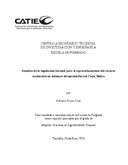| dc.contributor.author | Rosa Cruz, A. | |
| dc.date.accessioned | 2014-10-17T06:33:35Z | |
| dc.date.available | 2014-10-17T06:33:35Z | |
| dc.date.issued | 2010 | es_ES |
| dc.identifier | 375472 | es_ES |
| dc.identifier.uri | https://repositorio.catie.ac.cr/handle/11554/749 | |
| dc.identifier.uri | http://orton.catie.ac.cr/repdoc/A6271e/A6271e.pdf | es_ES |
| dc.description | Tesis (M. Sc) -- CATIE, Turrialba (Costa Rica), 2010 | es_ES |
| dc.description.abstract | El presente estudio fue realizado en el Distrito de El Cayo, Belice con el objetivo de analizar el marco legislativo y político vigente en el sector forestal del país en relación al aprovechamiento maderable en fincas agroforestales con énfasis en sistemas silvopastoriles (SSP) y promover el aprovechamiento del recurso maderable como fuente adicional de ingresos a los ganaderos.El marco político-legal resalta que el aprovechamiento del recurso maderable en los SSP de Belice se realiza mediante mecanismos simplificados por medio de un permiso pequeño, sin implicar grandes costos de transacción para los productores. Se concluye que un gran porcentaje (80%) de fincas poseen recursos maderables considerables que pueden contribuir a diversificar la Producción en SSP y también como una fuente alternativa de ingresos, pero que actualmente existen pocos individuos en la categoría de latizales y por lo tanto se requiere mejorar el manejo para garantizar el reclutamiento hacia clases mayores y de esa forma, obtener un manejo forestal sostenible dentro del sistema de árboles maderables en pasturas de la zona de estudio. This study was carried out in El Cayo District, Belize, with the aim of analyzing the existing legislation and policy framework of the forest national sector in relation to timber harvesting in agroforestry farMON. Emphasis was placed on silvopastoral systeMON (SPS) to promote the use of timber as an additional source of income to farmers.The political and legal framework highlights that the use of timber resources in SPS of Belize is done through simplified mechanisMON and through a small allowance, without involving large transaction costs for producers. It was concluded that a large percentage of farMON (80%) have significant timber resources that can help diversify production in SPS and that can also act as an alternative source of income. However, currently there are few individuals in the category of saplings that require better management to ensure the recruitment to higher classes and thus, obtain sustainable forest management within the system of timber trees within pastures in the study area. | es_ES |
| dc.language.iso | es | es_ES |
| dc.publisher | CATIE, Turrialba (Costa Rica) | es_ES |
| dc.subject | SWIETENIA MACROPHYLLA | |
| dc.subject | TECTONA GRANDISCEDRELA ODORATA | |
| dc.subject | RECURSOS FORESTALES | |
| dc.subject | APROVECHAMIENTO DE LA MADERA | |
| dc.subject | LEGISLACION POLITICAS | |
| dc.subject | SISTEMAS SILVOPASCICOLAS | |
| dc.subject | AGROFORESTERIA | |
| dc.subject | ANALISIS ECONOMICO | |
| dc.subject | BELICE | |
| dc.title | Challenges of forest legislation for timber use in silvopastoral systeMON of Cayo, Belize | es_ES |
| dc.title.alternative | Desafíos de la legislación forestal para el aprovechamiento del recurso maderable en sistemas silvopastoriles del Cayo, Belice | es_ES |
| dc.type | Tesis de maestría | es_ES |
| dc.identifier.publication | Turrialba (Costa Rica) | es_ES |


